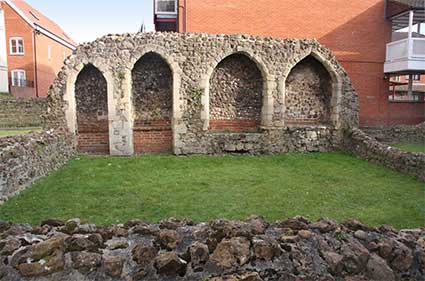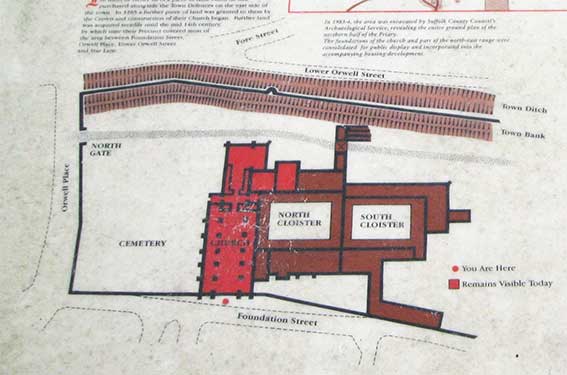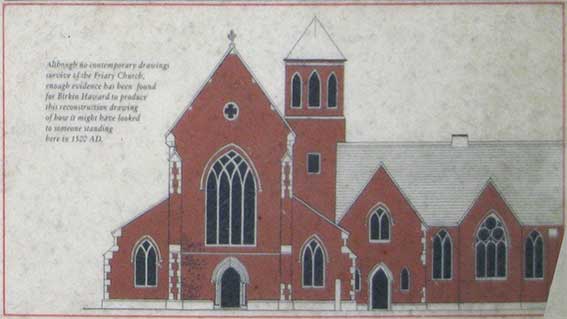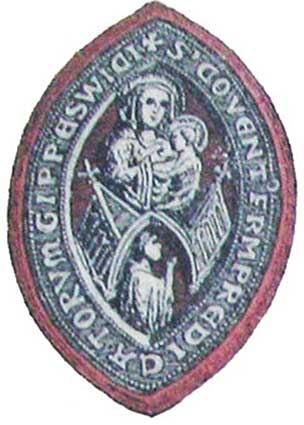Church
of St Mary, Blackfriars Friary of the Blessed Virgin
 2017 image
2017 image 
Above: views of the site looking towards Lower Orwell Street.
The second photograph, Arcade seats in the Friars' chapter house, is
courtesy John Norman. To the right is Blackfriars Court, a modern sheltered
housing complex.
The Friary church was dedicated to St Mary. It had substantial
aisles to north and south, and a choir separated nave and chancel, in
the cathedral manner. There was probably a central tower, and early
reports of a spired church seem to refer to this one. The chancel had a
chapel to the south, probaby constructed after a bequest by the Dukes
of Suffolk. Between this chapel and the nave were the chapter house and
the sacristy.
The following details are taken from the information board on Foundation Street are quite a revelation to
people who walk past the somewhat scant ruins of the old priory church.

Above: 'In 1983-4 the area was excavated by Suffolk County
Council's Archaeological Service, revealing the entire ground plan of
the northern half of the Friary. The foundations of the church and part
of the north-east range were consolidated for public display and
incorporated into the accompanying housing development.' It
is clear that the cemetery relating to the church stretched as far as
Orwell Place (formerly Stepples Street), so covered the site of today's
Unicorn inn and brewery. (See
the note about the extent of the overall site below.) Also
note the proximity of Town Ditch and Bank (rampart) running along a
line of the upper part of Fore Street and Lower Orwell Street (formerly
The Lower Wash).

Above: 'Although no contemporary drawings survive of the Friary
Church, enough evidence has been found for Birkin Haward to produce
this reconstruction drawing of how it might have looked to someone
standing here [in Foundation Street] in 1500 AD.'
 <The seal of Ipswich Blackfriars
<The seal of Ipswich Blackfriars
'During the medieval period, between 1139 and 1298, four
Religious Orders settled in Ipswich: two Austin Canon establishments
(Holy Trinity Priory and The Priory of St Peter & St Paul), the
Dominicans (Black Friars), the Carmelites (White Friars) and the
Franciscans (Grey Friars). Unlike Monastic Orders, which avoided
contact with the outside world, the Friars were preachers and social
workers who settled in towns to maximise their contact with the
population and were dependent upon them for their daily sustenance and
the upkeep of their buildings.
Ipswich Blackfriars was founded in 1263, following the gift to them by
Henry III of a piece of land which he had purchased alongside the Town
Defences on the east side of the town. In 1265 a further piece of land
was granted to them by the Crown and construction of their Church
began. Further land was acquired steadily unitl the mid-14th century;
by which time their Precinct covered most of the area between
Foundation Street, Orwell Place, Lower Orwell Street and Star Lane.'
As
early as the 15th century the Blackfriars
Priory was bringing in fresh water through wooden pipes from the
springs at Cauldwell Hall, as by the
time the surface spring water reached the town, it was polluted. See
our Water page for more information.
Note that an even bigger area of the town centre was occupied by
the White Friars. In 1278 the Carmelites, or Whitefriars, arrived. They
were a very learned order, spending their time studying and lecturing,
much in the manner of a modern university. They had their Friary
roughly where the Buttermarket Shopping Centre stands today. During the
course of the 14th century, it expanded rapidly, and stretched all the
way from Queen Street to St Stephens Lane. It was the biggest
foundation in Ipswich, and one of the largest Carmelite communities in
England. No trace of it survives.
'The Ipswich Friaries were closed by Henry VII in the early 16th
century and most of the buildings were demolished. The Blackfriars
Church was certainly demolished at this time (1538) but most of the
other buildings were retained for alternative uses and at different
periods housed an Almshouse (Tooley and
Smart's), Christ's Hospital,
the Grammar School, the Town Library, the Bridewell (prison) and the
Town Arsenal. By 1850 the last of these remaining buildings had been
finally demolished, but fortunately a plan and prospect of the
surviving Friary buildings was drawn by Joshua Kirby in 1748 just
before any demolition had started.'
Thanks also to Simon's Suffolk Churches (see Links) for further information.
Home
Please email any comments and contributions by clicking here.
Search Ipswich
Historic Lettering
©2004 Copyright
throughout the Ipswich
Historic Lettering site: Borin Van Loon
No reproduction of text or images without express
written permission
 2017 image
2017 image 


 <The seal of Ipswich Blackfriars
<The seal of Ipswich Blackfriars